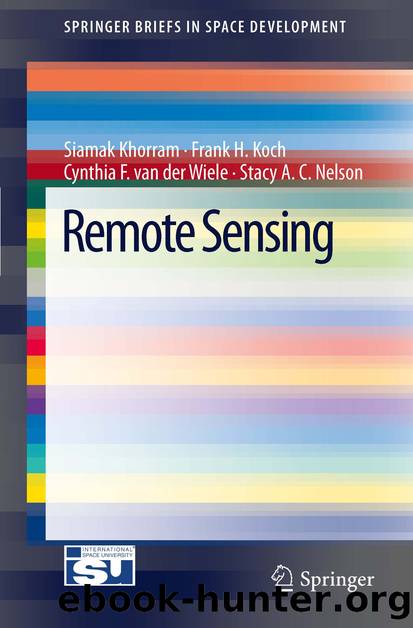Remote Sensing by Siamak Khorram Stacy A.C. Nelson Frank H. Koch & Cynthia F. van der Wiele

Author:Siamak Khorram, Stacy A.C. Nelson, Frank H. Koch & Cynthia F. van der Wiele
Language: eng
Format: epub
Publisher: Springer US, Boston, MA
In a study by Nelson et al. (2003), Landsat-7 data was used to investigate the relationship between spectral values extracted from Landsat Enhanced Thematic Mapper (ETM+) data and water clarity using Secchi disk transparency (SDT) measurements (Fig. 4.3).
Fig. 4.3Secchi disk transparency has been used as a simple method of determining water clarity. The Secchi depth is inversely proportional to absorbance of light by water and dissolved or particulate substances, such as algal biomass
Models that incorporate this complete range of SDT values may not produce statistical relationship results as high as models that are developed for groups of lakes that don’t incorporate the full regional range of SDT values (Lathrop and Lillesand 1986, Dekker and Peters 1993, Kloiber et al. 2000). In addition, Landsat may be better suited for predicting shallow SDT values (eutrophic-higher algal biomass) than clearer water containing deeper SDT values (Fig. 4.4). These types of models, based on remotely sensed data, have the capacity to provide managers with a method to inventory shallow SDT lakes across the entire state where in situ data is difficult to obtain. In particular, regulatory and management agencies would be able to monitor private lakes without spending resources on these lakes and without requiring the permission of the property owner. Additionally, models developed from remotely sensed data may be useful in the historical analysis of watershed changes that may have caused lake eutrophication to occur over time. This application is a very attractive use of remote sensing since historical imagery may be obtained for aquatic systems that have become eutrophic over time.
Fig. 4.4The physical appearance of a water body with a shallow Secchi Disk Transparency (SDT) value vs deep SDT value can be very different. The image on the left represents a shallow SDT measurement where the water may be discolored dues to high algal biomass content, sediment, or etc. The image on the right represents a deep SDT measurement where the water appears clearer. Thus, the measurement of SDT values can provide important information as an indication of water clarity
Download
This site does not store any files on its server. We only index and link to content provided by other sites. Please contact the content providers to delete copyright contents if any and email us, we'll remove relevant links or contents immediately.
Sass and Compass in Action by Wynn Netherland Nathan Weizenbaum Chris Eppstein Brandon Mathis(7915)
Autodesk Civil 3D 2024 from Start to Finish by Stephen Walz Tony Sabat(7085)
Mathematics for Game Programming and Computer Graphics by Penny de Byl(6999)
Taking Blender to the Next Level by Ruan Lotter(6794)
Express Your Creativity with Adobe Express by Rosie Sue(6600)
Hands-On Unity 2022 Game Development - Third Edition by Nicolas Alejandro Borromeo(6206)
Hands-On Unity 2022 Game Development by Nicolas Alejandro Borromeo(5051)
Unreal Engine 5 Character Creation, Animation, and Cinematics by Henk Venter & Wilhelm Ogterop(3937)
Going the Distance with Babylon.js by Josh Elster(3903)
Mastering Graphics Programming with Vulkan by Marco Castorina & Gabriel Sassone(3783)
Squeaky Clean Topology in Blender by Michael Steppig(3783)
Adobe Illustrator for Creative Professionals by Clint Balsar(3733)
Drawing Shortcuts: Developing Quick Drawing Skills Using Today's Technology by Leggitt Jim(2959)
Unreal Engine 5 Character Creation, Animation, and Cinematics by Henk Venter Wilhelm Ogterop(2907)
Rapid Viz: A New Method for the Rapid Visualization of Ideas by Kurt Hanks & Larry Belliston(2791)
The 46 Rules of Genius: An Innovator's Guide to Creativity (Voices That Matter) by Marty Neumeier(2721)
Learn Qt 5: Build modern, responsive cross-platform desktop applications with Qt, C++, and QML by Nicholas Sherriff(2393)
Fusion 360 for Makers by Lydia Sloan Cline(2261)
Hands-On Neural Networks with Keras by Niloy Purkait(2208)
